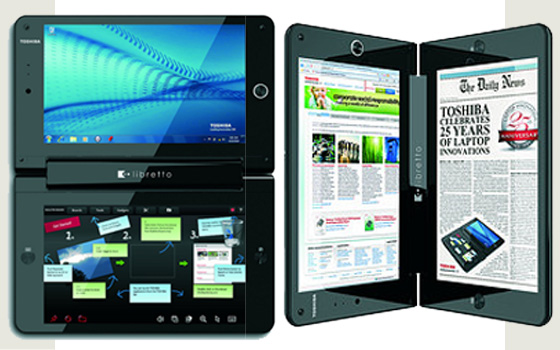Toshiba Libretto Dual-Screen – Laptop Or Double-Winged Tablet?

The Libretto dual-screen laptop looks like something that came out of the future. For years manufacturers would present something similar at the fairs so that die hard geeks could have something to drool over, but never really brought it to the market. Until now…
Design
The two capacitive touch screens of the Libretto are identical, but the lids they’re built in slightly differ. The upper lid is covered in gray bruised metal and has the Libretto logo imprinted on and has a speaker strip at the bottom. The bottom lid is made of plastic and has two rubber feet for using in laptop mode. Even though the Libretto seems fragile, it’s very solid and the juncture that connects the screens feels stabile.
The small displays make the device only 7.95 inches wide when folded and 1.2 inches thick. When it’s completely opened it resembles the size of a tablet, but it is actually little shorter than the iPad.
Displays
Undoubtedly, the Librettos main traits are the two 7” LDC displays. The screens are exceedingly shiny, which makes it almost impossible to use the device in the sunlight. Tablets also have this problem, so it’s not much of a setback. The viewing angle of the screens is not bad for a small laptop like the Libretto, but it’s not impressive either. The device has a built in accelerometer that allows it to be used in e-book reading mode, but it only works if you rotate the screen clockwise.
Both capacitive touch screens are too touchy – literary. They respond to light tap or gesture way to easily. On the left of the upper screen there is a 1MP camera that actually makes pretty descent photos and videos.
Software
Toshiba decided to use Windows 7 Home Premium on the Libretto and it proved to somewhat difficult to use. Browsing through narrow menus and selecting items can be painstaking job when working on a small touch screen, and to be fairly honest, Windows 7 may be optimized for touch, but it’s not a touch centric OS. We suggest using mouse for these kinds of operations.
In order for the users to completely exploit the advantages of the dual screen, Toshiba has built in software tool that integrates the two windows. You can spread a window across the two panes or drag the windows from one screen to the other.
Maybe Toshiba were aware of the fact that Windows 7 cannot meet with all the requirements from the users so there are some tools that they developed on their own.
Hardware and Battery
The Libretto may look like something that came from the future, but its performance is limited by today’s technology. The 1.2GHz Pentium U500 processor, 64GB SSD and 2GB RAM are quite powerful parts and can easily cope with everyday tasks. But they are too powerful for the chassis so there is a constant issue with the heating.
The powerful innards also affect the battery life and the 36Wh 6-cell battery lasts for only up to 2 and a half hour with video streaming, Wi-Fi on, and 65% brightness.
The Verdict
Even though the Libretto has some major drawbacks, it’s nice to know where laptop design might move towards in the future. Probably the geeks are not the only ones who would payout to have this gadget since it is fairly fun to use it.
